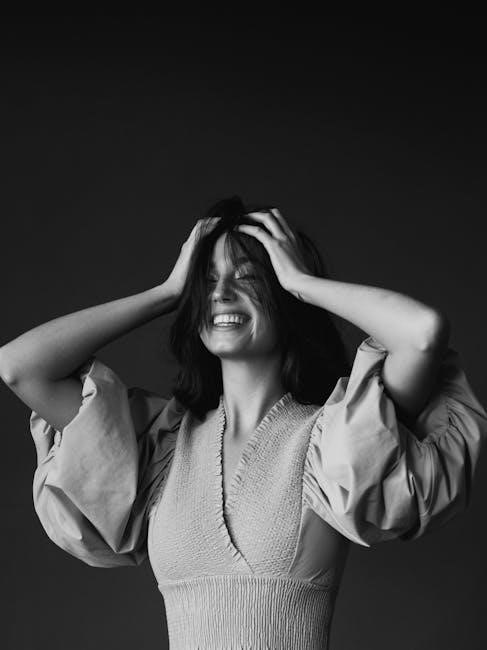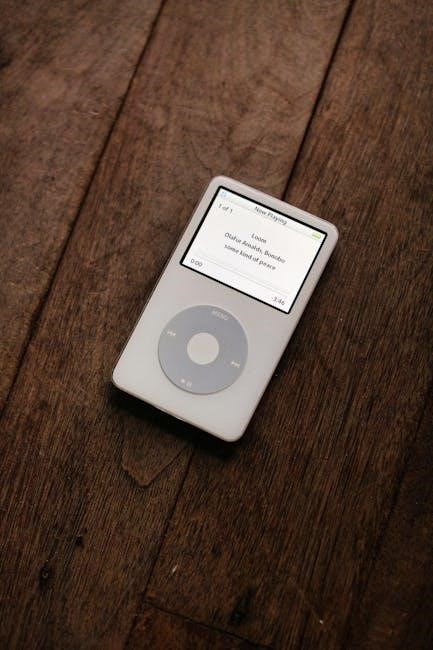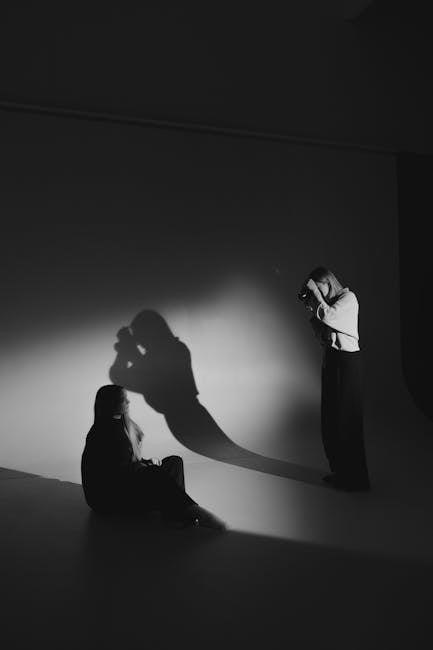b&l ultra for presbyopia fitting guide
Presbyopia, a common age-related vision condition, impacts near vision, making everyday tasks challenging. Proper fitting of B&L Ultra lenses ensures comfort and clarity, enhancing quality of life. This guide provides a comprehensive approach to evaluating, selecting, and fitting these lenses, offering practical insights for eye care professionals to optimize patient outcomes.
1.1 Overview of Presbyopia and Its Impact on Vision
Presbyopia is a natural, age-related condition that affects the eye’s ability to focus on near objects. It typically begins in the early to mid-40s, as the crystalline lens loses flexibility and elasticity, reducing accommodation. This results in difficulty with tasks like reading, using digital devices, or performing close-up work. The condition progresses over time, worsening near vision acuity. Presbyopia impacts daily activities, causing eye strain and frustration. Understanding its biological basis is crucial for developing effective correction strategies, such as B&L Ultra lenses, which address these challenges by optimizing visual clarity across different distances.
1.2 Importance of Proper Fitting for Presbyopia Correction
Proper fitting is essential for effective presbyopia correction, ensuring optimal visual clarity and comfort. Incorrectly fitted lenses can lead to eye strain, blurred vision, and dissatisfaction. A well-executed fitting process considers pupil size, lifestyle, and refractive needs, tailoring the solution to individual requirements. B&L Ultra lenses, with their advanced design, require precise measurements to maximize their benefits. Accurate fitting enhances near, intermediate, and far vision, improving daily activities and overall quality of life. This guide emphasizes the critical role of proper fitting in achieving successful outcomes with B&L Ultra lenses.
1.3 What to Expect in This Guide
This comprehensive guide provides a detailed approach to fitting B&L Ultra lenses for presbyopia, ensuring optimal outcomes. It covers pre-fitting evaluations, lens selection, and trial fitting processes. The guide also addresses post-fitting care and troubleshooting common issues. Practical insights and tips are included to enhance the fitting experience. By following this guide, eye care professionals can effectively address presbyopia, improving patient satisfaction and visual clarity. The content is structured to offer clear, actionable steps, making it an invaluable resource for successful B&L Ultra lens fittings.

Understanding Presbyopia
Presbyopia is an age-related condition affecting near vision, typically starting in the early to mid-40s. It occurs as the crystalline lens loses elasticity, reducing accommodation ability.
2.1 Definition and Causes of Presbyopia
Presbyopia is an age-related vision condition that gradually reduces the eye’s ability to focus on near objects. It typically begins in the early to mid-40s and progresses over time. The primary cause is the crystalline lens’s loss of elasticity, impairing its ability to accommodate or change shape for focusing. Environmental factors like prolonged screen use may exacerbate symptoms, but the root cause is the natural aging of the lens. This results in difficulty reading, blurred vision at close distances, and eye strain during near tasks. Understanding these factors is essential for effective correction, such as with B&L Ultra lenses.
2.2 Symptoms of Presbyopia
Presbyopia typically presents with difficulty focusing on near objects, such as small text or fine details. Common symptoms include blurred vision when reading, eye strain, and headaches during close-up tasks. Patients often find themselves holding objects farther away to see clearly. The condition progresses gradually, with symptoms becoming more noticeable in the early to mid-40s. Everyday activities like reading, using digital devices, or performing hobbies become challenging. These symptoms result from the lens’s reduced ability to accommodate, leading to frustration and discomfort. Recognizing these signs is crucial for timely correction, such as with B&L Ultra lenses, designed to restore clear near and intermediate vision.
2.3 How Presbyopia Affects Daily Activities
Presbyopia significantly impacts daily life, making tasks requiring near vision increasingly challenging. Reading, cooking, and using digital devices become frustrating due to blurred vision. Difficulty focusing on small details, such as medication labels or phone screens, can lead to errors or accidents. Social interactions may suffer as activities like dining or conversing in low-light settings become strained. The inability to perform hobbies, such as sewing or reading, can cause emotional distress. Presbyopia also affects occupational responsibilities, particularly for individuals requiring precise near vision. These challenges highlight the importance of addressing presbyopia with solutions like B&L Ultra lenses to restore clarity and independence in daily routines.

Overview of B&L Ultra Lenses
B&L Ultra lenses are cutting-edge, customizable solutions designed to address presbyopia with advanced optics and improved visual clarity, offering tailored correction for near, intermediate, and far vision needs.
B&L Ultra lenses are premium, customizable presbyopia-correcting lenses designed to enhance visual clarity and comfort. They utilize advanced optical technology to address the unique challenges of presbyopia, offering sharp vision at all distances. These lenses are tailored to individual pupil sizes and refractive needs, ensuring optimal performance. With a focus on adaptability and precision, B&L Ultra lenses aim to provide seamless transitions between near, intermediate, and far vision, making them a versatile solution for patients seeking reliable and comfortable correction. Their innovative design and personalized approach set them apart as a preferred choice for addressing presbyopia effectively.
3.2 Key Features of B&L Ultra Lenses
B&L Ultra lenses boast several standout features, including optimized aspheric designs that reduce distortions and enhance optical clarity. Their advanced multifocal technology ensures smooth transitions between near, intermediate, and far vision, providing consistent performance. The lenses are customizable to fit individual pupil sizes, allowing for precise alignment and improved visual acuity. Additionally, they incorporate anti-reflective coatings to minimize glare and improve low-light visibility. These features collectively contribute to a natural, comfortable wearing experience, making B&L Ultra lenses a superior choice for addressing presbyopia with precision and adaptability. Their tailored approach ensures optimal vision correction, catering to diverse patient needs effectively.
3.3 Benefits of B&L Ultra Lenses for Presbyopia
B&L Ultra lenses offer numerous benefits for individuals with presbyopia, including enhanced near, intermediate, and far vision with minimal visual distortion. Their customizable design ensures a tailored fit, improving comfort and optical performance. The lenses reduce eye strain and fatigue, allowing wearers to focus effortlessly across various distances. Anti-reflective coatings minimize glare, enhancing visibility in low-light conditions. These features collectively provide a seamless, natural visual experience, enabling wearers to maintain an active lifestyle without compromising on clarity or comfort. By addressing the specific challenges of presbyopia, B&L Ultra lenses deliver a reliable and adaptable solution for everyday vision needs.

Pre-Fitting Considerations
Assessing patient needs, evaluating pupil size, and considering lifestyle are crucial for optimal B&L Ultra lens fitting, ensuring a tailored and comfortable solution for presbyopia correction.
4.1 Patient Evaluation and Needs Assessment
A comprehensive patient evaluation is essential to determine the suitability of B&L Ultra lenses for presbyopia correction. This involves assessing the patient’s visual acuity, refractive needs, and lifestyle preferences. Understanding the patient’s daily activities, such as reading, driving, or using digital devices, helps in selecting the most appropriate lens design. Additionally, evaluating the patient’s adaptation to multifocal lenses and their expectations from the correction is crucial. This step ensures a personalized approach, addressing specific visual demands and promoting satisfaction with the B&L Ultra lenses. A detailed needs assessment guides the selection process, ensuring optimal visual outcomes and comfort for the patient.
4.2 Understanding Pupil Size and Its Role in Fitting
Pupil size plays a critical role in the fitting of B&L Ultra lenses for presbyopia correction. The natural variation in pupil size, particularly in low-light conditions, can influence how the lens performs. Larger pupils may result in the simultaneous presence of multiple focal points, potentially causing visual distortion. Conversely, smaller pupils may limit the effectiveness of near and intermediate zones. Accurate measurement and understanding of pupil dynamics ensure proper lens centration and alignment, optimizing visual clarity. B&L Ultra lenses are designed to adapt to varying pupil sizes, providing consistent performance across different lighting environments. This adaptability enhances the wearer’s ability to transition smoothly between near, intermediate, and far vision tasks.

4.3 Lifestyle Considerations for Lens Selection
Lifestyle considerations are essential when selecting B&L Ultra lenses for presbyopia correction. Factors such as profession, hobbies, and daily activities influence the choice of lens design and features. For example, individuals with active lifestyles or those frequently transitioning between indoor and outdoor environments may benefit from lenses with enhanced depth of focus and minimized glare. Additionally, individuals who rely heavily on near or intermediate vision, such as readers or computer users, may require specific zone configurations. B&L Ultra lenses are designed to adapt to these diverse needs, offering customization options to ensure optimal visual performance in varying conditions. This tailored approach enhances comfort and functionality, making them ideal for dynamic lifestyles.

The Fitting Process
The fitting process involves a thorough assessment, lens selection, and trial fitting to ensure optimal comfort and vision correction. Adjustments are made to meet individual needs.
5.1 Initial Consultation and Eye Examination
The initial consultation and eye examination are critical for understanding the patient’s needs and ensuring proper fitting of B&L Ultra lenses. During this step, the eye care professional evaluates the patient’s visual acuity, refractive errors, and pupil size. A comprehensive eye exam is conducted to assess the health of the retina, optic nerve, and other structures. The patient’s lifestyle and visual demands are discussed to tailor the lens selection. This step also involves educating the patient about presbyopia and the benefits of B&L Ultra lenses, ensuring realistic expectations and a smooth transition to the fitting process.
5.2 Lens Selection Based on Refractive Needs
Lens selection for B&L Ultra lenses involves a detailed analysis of the patient’s refractive needs, including myopia, hyperopia, and astigmatism. The practitioner evaluates the patient’s prescription to determine the appropriate lens power and design. Pupil size, measured during the initial consultation, plays a crucial role in optimizing near and intermediate vision. Advanced optics in B&L Ultra lenses are tailored to address presbyopia by enhancing depth of focus and minimizing visual disturbances. The lenses are designed to provide sharp vision at all distances, ensuring seamless transitions between tasks. Personalized calculations ensure the selected lenses align with the patient’s lifestyle and visual demands, maximizing comfort and clarity.
5.3 Trial Lens Fitting and Adjustment
Trial lens fitting is a critical step in ensuring optimal performance of B&L Ultra lenses. Patients are provided with trial lenses to evaluate comfort and vision clarity. The practitioner assesses near, intermediate, and far vision, making adjustments as needed. Feedback from the patient is crucial, guiding modifications to lens power or design. Pupil size and centration are checked to ensure proper alignment, minimizing visual disturbances. Adjustments may involve slight changes in lens parameters to enhance focus and depth perception. This iterative process ensures a tailored fit, maximizing the patient’s visual experience and satisfaction with B&L Ultra lenses.
5.4 Finalizing the Prescription
After successful trial lens fitting, the prescription is finalized by confirming lens specifications and ensuring optimal alignment with the patient’s eyes. The practitioner reviews near, intermediate, and far vision performance, incorporating any final adjustments based on patient feedback. Accurate centration and pupil size alignment are verified to maximize visual clarity. The prescription is then tailored to the patient’s unique needs, considering lifestyle and refractive requirements. Finalizing the prescription ensures a precise fit, delivering enhanced vision across all distances. This step is crucial for patient satisfaction and the overall success of B&L Ultra lenses in addressing presbyopia.

Post-Fitting Follow-Up
Regular follow-up appointments ensure the lenses perform optimally, addressing any discomfort or vision issues. Adjustments are made to refine fit and clarity, ensuring continued patient satisfaction and comfort.

6.1 Importance of Follow-Up Appointments
Follow-up appointments are crucial for ensuring the long-term success of B&L Ultra lens fittings. These visits allow eye care professionals to assess lens performance, address any adaptation issues, and make necessary adjustments. Patients may experience initial discomfort or vision distortions, which can often be resolved with minor tweaks. Regular check-ups also help in monitoring the progression of presbyopia and adapting the lenses accordingly. By prioritizing follow-ups, patients can maintain optimal vision clarity and comfort, ultimately enhancing their quality of life. Consistent monitoring ensures the lenses continue to meet the patient’s evolving needs, providing a seamless and satisfactory wearing experience over time.
6.2 Adjustments and Fine-Tuning the Fit
Post-fitting adjustments are essential to ensure B&L Ultra lenses perform optimally for presbyopia correction. Common tweaks include refining lens centration, prism alignment, or vertex distance to match the patient’s refractive needs. Fine-tuning may also involve modifying the near, intermediate, or far vision zones for clearer focus. Patient feedback is critical during this phase, as subtle changes can significantly impact comfort and visual acuity. Eye care professionals may use diagnostic tools to assess lens performance and make precise adjustments. These refinements ensure the lenses adapt seamlessly to the patient’s lifestyle, providing sharp vision across all distances and minimizing visual strain.
6.3 Managing Patient Expectations
Setting realistic expectations is crucial for patient satisfaction with B&L Ultra lenses. Patients should understand that adaptation to multifocal lenses may take time, especially for those new to presbyopia correction. Eye care professionals should communicate the benefits of B&L Ultra lenses, such as enhanced near, intermediate, and far vision, while also explaining that minor distortions or adaptation periods are normal. Regular follow-ups and open communication help address concerns promptly. Educating patients on proper lens care and usage further ensures a smooth transition. By aligning expectations with the capabilities of B&L Ultra lenses, practitioners foster trust and long-term patient confidence in their presbyopia correction.

Troubleshooting Common Fitting Issues
Addressing discomfort, vision distortion, or positioning problems with B&L Ultra lenses requires careful analysis. Identify root causes, adjust lens parameters, and ensure proper centration for optimal results.
7.1 Addressing Discomfort or Vision Distortion
Discomfort or vision distortion with B&L Ultra lenses may stem from improper centration, incorrect power, or lens mismatch. Ensure proper alignment with pupil size and refractive needs. Adjust lens positioning to minimize distortion. Consider lifestyle factors influencing visual comfort. Fine-tune prescriptions for optimal clarity and reduce eye strain. Regular follow-ups help identify and resolve issues promptly, ensuring a seamless adaptation to the lenses.
7.2 Resolving Issues with Near, Intermediate, or Far Vision
Issues with near, intermediate, or far vision in B&L Ultra lenses may arise from incorrect lens power or design mismatch. Evaluate the patient’s specific visual demands and ensure the lenses are tailored to their refractive needs. For near vision problems, verify the add power and consider adjustments. Intermediate vision issues may require tweaking the progressive design. Far vision clarity can be enhanced by ensuring accurate centration and proper alignment with pupil size. Trial lenses can help identify discrepancies, and fine-tuning the prescription based on patient feedback is essential. Regular follow-ups allow for adjustments, optimizing visual performance across all distances.
7.3 Handling Lens Centration and Positioning Problems
Proper lens centration and positioning are critical for optimal vision with B&L Ultra lenses; Misalignment can lead to vision distortion, eye strain, or difficulty switching between near and far focus. Use trial frames and measurement tools to ensure accurate centration relative to the pupil. Adjust the frame’s position to align the lens design with the visual axis. Verify the fit using the corneal reflex method to ensure symmetry. If issues persist, consider remeasuring or rebasing the lenses. Post-fitting adjustments may be necessary to fine-tune the alignment, ensuring the lenses perform as intended and provide clear, comfortable vision for the patient.

B&L Ultra lenses offer a tailored solution for presbyopia, combining advanced optics with personalized fitting. This guide provides essential insights to ensure optimal vision correction.
8.1 Summary of Key Fitting Principles
Successful fitting of B&L Ultra lenses for presbyopia requires a thorough patient evaluation, considering lifestyle and visual needs. Accurate measurement of pupil size ensures optimal lens centration, minimizing visual disturbances. Proper lens selection, based on refractive requirements and near-vision demands, is crucial. Trial lenses allow real-time adjustments, ensuring comfort and clarity. Post-fitting follow-ups are essential to fine-tune the fit and address any adaptation issues. By combining these principles, eye care professionals can deliver personalized solutions, enhancing patient satisfaction and visual performance with B&L Ultra lenses.
8.2 Final Tips for Successful B&L Ultra Fittings
For optimal results with B&L Ultra lenses, prioritize clear communication with patients to ensure their needs and expectations are met. Emphasize the importance of realistic expectations and gradual adaptation. Leverage advanced fitting tools, such as the B&L Ultra Fitting Guide, to streamline the process. Perform thorough post-fitting evaluations and encourage follow-up appointments to address any adjustments. Stay updated on the latest fitting techniques and technological advancements. By combining these strategies, eye care professionals can maximize patient satisfaction and deliver exceptional visual outcomes with B&L Ultra lenses.
